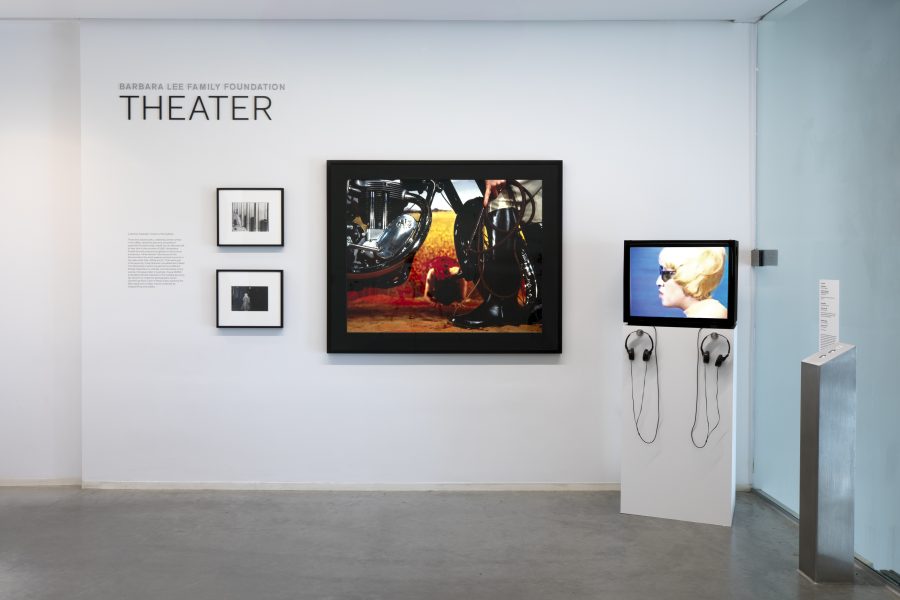
Installation view, Collection Spotlight: Avatars of the Eighties, the Institute of Contemporary Art/Boston, 2025. Photo by Mel Taing.
These lens-based works, created by women artists in the 1980s, reveal the personal and political potential of transforming oneself into an alternate self. In New York in the summer of 1980, Howardena Pindell donned a wig and sunglasses to become an anonymous “white woman” who discounts the discrimination the artist experienced and recounts in her video work Free, White and 21. That same year in the same city, Cindy Sherman completed the Untitled Film Still series in which she performs as different female characters to critically recontextualize movie scenes. Nine years later in Australia, Tracey Moffatt embodied a female character in the Outback pursuing her dreams to create the photographic series Something More. Each of these artists explores the fabricated and complex nature of identity by shapeshifting into avatars.
Zoe Pettijohn Schade creates painstaking paintings on paper, often working for years on works that take a unique approach to pattern and repetition. The recent work Attempts at Self Organization: Prevailing Bonds, on view in the third floor lobby, is an exploration of fundamental states of being that evoke the cellular, the atomic, and the elemental.Its title refers to the writings of Plato, St. Augustine, and French biologist Stéphane Leduc, who each informed the artist’s sense of how there is meaning in how forms are organized. Here, marbled paint serves as the foundation for a dizzying array of formal explorations, including mirrored cubes, hexagons, diamonds, feathers, leaves, and Rorschach-like ink blots, which for the artist create self-contained worlds, each with their own atmosphere. The interplay of thin metallic lines forms an elaborative configuration of geometric shapes. While the distribution of matter may appear chaotic and overwhelming, tiny details repeat and recur throughout. Through long periods of close looking, the layers of Pettijohn Schade’s organizing structure jostle for position, struggling to exert the bond between themselves and others in a process that evokes life at every scale.
Nan Goldin and Jack Pierson were part of the “Boston School”—a group of loosely affiliated artists who met in Boston in the late 1970s and 80s and focused much of their work on the queer underground scene in and around the city. At the time, photography was a powerful form of documentation in an era shaped by the AIDS pandemic. Two works from the ICA’s permanent collection installed together on the third floor point to the artists’ shared interest in performance and its emotional capacities.
Goldin attended School of the Museum of Fine Arts (1974–78) and has spent decades capturing overlooked subjects and the intimacies of everyday life. In 1994, Goldin published Tokyo Love together with Japanese photographer Nobuyoshi Araki. An artist book documenting contemporary adolescence in Tokyo, the book celebrates youthful energy and romance as well as the subjects’ fluid sexuality and gender identities during a period of government-imposed censorship. Noa Dressing for the Venus Show at Shogun Club, Tokyo is a portrait of two performers preparing for the stage as one fastens the other’s costume. The name Shogun Club references a queer history of Shoguns—top military commanders in feudal Japan—who often brought beautiful young men as Geishas for entertainment during wartime. The necessity of queer kinship and care is foregrounded here and across Goldin’s work.
A graduate of the Massachusetts College of Art in 1984, Pierson is known for his photographs, sculptures, and text-based artworks that often draw on commercial signage and popular culture to explore nostalgia, desire, and disillusion. Applause is a re-creation of the sign used in television studios that, when lit, directs audiences to clap at pre-determined moments during tapings of a program. A kind of instructional device, Applause is a work of irony—drawing attention to the gulf between what one says and means. Pierson’s sculpture encourages viewers to question our emotional reactions to signs and signals.
Xaviera Simmons pursues a research-based practice that spans photography, performance, video, sound, sculpture, and installation, and explores the experiences, memories, and histories of African diasporas. In the series Sundown (2018–present), referencing “sundown towns” where many Black Americans are not welcomed in public space after dark, Simmons utilizes clothing, props, backdrops, and historic photographs to mine and reflect on Black experience across time. Sundown (Number Twelve) (2018) is in the museum’s permanent collection and was featured in the exhibition When Home Won’t Let You Stay: Migration through Contemporary Art, on view at the ICA in 2019.
NOTE: Exhibition dates subject to change.
The ICA is committed to sharing artists’ perspectives on the world. These two photographs are in the museum’s permanent collection and were made in Ukraine by photographer Boris Mikhailov, who was featured in a solo exhibition at the ICA in 2004.
Mikhailov’s hometown of Kharkiv provided the backdrop to his series Case History, which documents people experiencing homelessness after the collapse of the Soviet Union in the early 1990s. For over 40 years, Mikhailov has explored the position of the individual within the historical mechanisms of public ideology, touching on such subjects as Ukraine under Soviet rule, the living conditions in post-communist Eastern Europe, and the fallen ideals of the Soviet Union. His life-size color photographs document the oppression, poverty, and everyday reality of a disenfranchised community living on the margins of what was then Russia’s new economic regime. These searing images point to Ukraine as a place of beauty, deep history, trauma, and tragedy, both past and, with Russia’s unprovoked invasion of Ukraine, in the present.
NOTE: Exhibition dates subject to change.